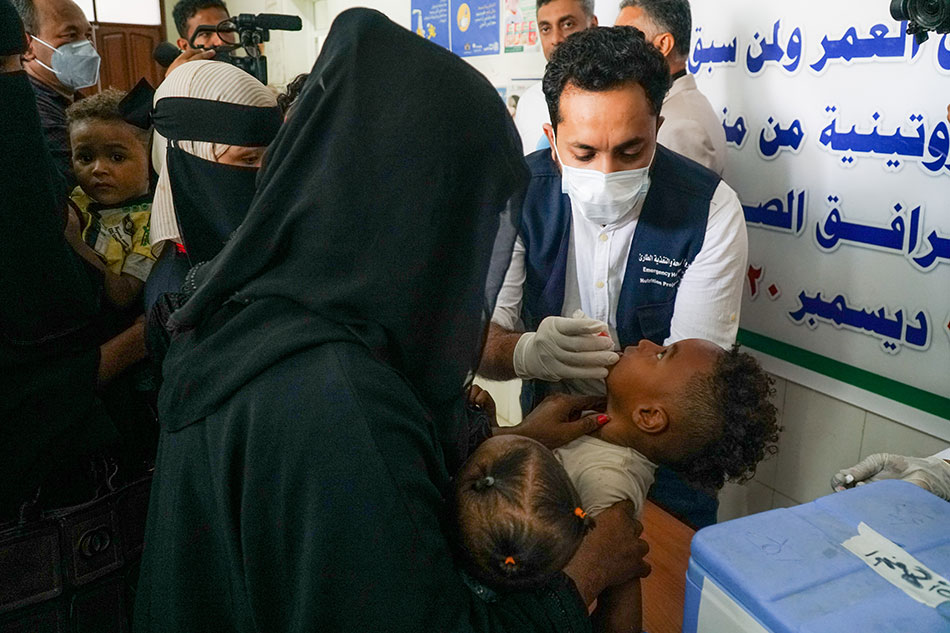
Yemen, classified by WHO as a level three emergency, is experiencing a complex and sustained crisis marked by ongoing conflict, devastated infrastructure including healthcare services, poverty, hunger, and a surge in vaccine-preventable diseases.
Yemen has been free of wild poliovirus since 2006, but in 2020 an outbreak of circulating vaccine-derived poliovirus type 1 (cVDPV1) was declared. To date, 35 children have been paralysed in the outbreak, which has its epicentre in Sa’adah governorate, a region where house to house vaccination, the gold standard for creating robust immunity to poliovirus, has not been permitted for some years. In late 2021, cases of paralytic polio caused by vaccine-derived poliovirus type 2 were also detected.
Detecting and responding to a cVDVP1 outbreak
The detection of Yemen’s cVDPV1 outbreak was delayed: a backlog of samples from children with acute flaccid paralysis (AFP) had built up inside the country, and when samples started to move to labs in early 2020, the most recent and highest-priority samples were tested first. This was crucial in enabling the programme to detect the cVDPV1 outbreak.
Thirty-one of the 35 cases had onset of paralysis in 2020. One child was paralysed in 2019, though detection was delayed to 2020, and three in 2021. It is thought that the virus began circulating as early as 2017.
Outbreak response activities are ongoing, and include
One round of national immunization days (NIDs) in November-December 2020.
One round of sub-national immunization days (SNIDs) in 13 northern governorates, excluding Sa’adah governorate, in May 2021.
Four rounds of integrated outreach in Sa’adah governorate in December 2020, March 2021, June 2021 and October 2021; children offered bivalent oral polio vaccine (bOPV), measles, rubella and diphtheria vaccination and nutritional services. bOPV is also being added to a MR vaccination campaign which was conducted in Sa’adah governorate in December 2021.
A second, concurrent outbreak: cVDPV2
In November 2021, two cases of vaccine-derived poliovirus type 2 (cVDPV2) were confirmed in Marib district of Marib governorate, and Thubab district of Taiz governorate. This outbreak of cVDPV2 is separate and distinct from the ongoing outbreak of cVDPV1, the epicenter of which is in Sa’adah governorate, in the north-west of the country. The two cases are related to each other, but not to any other VDPV2, making this a new emergence. In December 2021, a further six cases were confirmed from four governorates (Aden, Taiz, Marib and Sa’adah), and as of March 2022, the outbreak had paralysed 27 children, with more cases expected following processing of backlogged stool samples.
The programme is working with the Ministry of Public Health to conduct three nationwide polio campaign by using tOPV. Campaigns were carried out in Yemen’s southern governorates in February and March 2022, with a third round scheduled for May 2022. Seven in 10 Yemeni children under age 10 live in the country’s northern governorates, underscoring the urgency of completing national coverage with high-quality, house-to-house campaigns.
Polio surveillance in Yemen
Whilst there have been delays moving stool samples to the laboratory, Yemen has a well-established network for detection of AFP cases in communities. Every governorate has one to three dedicated AFP Surveillance Coordinators, and there is at least one Rapid Response Team in each district to respond to suspected cases. There are AFP focal points based in main health facilities in the country, who are regularly trained by the programme and frequently visited during active surveillance visits to make sure no AFP case is missed. In addition, the programme runs community orientation sessions to raise awareness of symptoms of polio, and polio vaccination teams also ask families during polio campaigns whether they know of any AFP cases in their neighbourhood.
In 2021, the polio programme initiated environmental surveillance in Sana’a, Aden and Hudaydah to detect the virus even in the absence of human polio cases.
AFP samples and environmental isolates are shipped out of Yemen either to the Polio National Laboratory in Muscat, Oman, or KEMRI in Nairobi, Kenya. Meanwhile, plans are underway to improve Yemen’s laboratory testing capacity, one of the foundations of a robust polio surveillance system.




